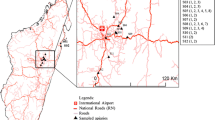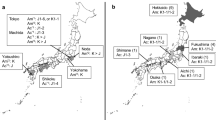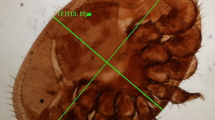Abstract
The aim of this study was to investigate the genetic diversity of Varroa destructor parasitizing Apis mellifera colonies and to test for possible host–parasite association at the mitochondrial DNA (mtDNA) level. Six A. mellifera haplotypes (including a novel C2aa) and five haplotypes of V. destructor were detected in 29 analyzed colonies from eight sampling sites in Serbia. We revealed the presence of the K and S1 haplotypes as well as KS1 and KP1 heteroplasmic mite individuals in all localities, while the P1 haplotype was only found in four sampling sites. Significant differences in V. destructor genetic diversity were found at both apiary and colony levels, with mite haplotypes coexisting in almost all tested colonies. In addition, a significant correlation between the number of analyzed mites per colony and the number of identified V. destructor haplotypes was observed. However, no significant host–parasite relationship was found, suggesting that mites bearing different haplotypes as well as those heteroplasmic individuals are well adapted to the host, A. mellifera, independently of the identified haplotype present in each colony. Our results will contribute to future population and biogeographic studies concerning V. destructor infesting A. mellifera, as well as to better understanding their host–parasite relationship.


Similar content being viewed by others
References
Anderson DL, Morgan MJ (2007) Genetic and morphological variation of bee-parasitic Tropilaelaps mites (Acari: Laelapidae): new and re-defined species. Exp Appl Acarol 43(1):1–24
Anderson DL, Trueman JWH (2000) Varroa jacobsoni (Acari: Varroidae) is more than one species. Exp Appl Acarol 24(3):165–189
Beaurepaire AL, Ellis JD, Krieger KJ, Moritz RF (2017) Association of Varroa destructor females in multiply infested cells of the honeybee Apis mellifera. Insect Sci. https://doi.org/10.1111/1744-7917.12529
Beaurepaire AL, Truong TA, Fajardo AC, Dinh TQ, Cervancia C, Moritz RF (2015) Host specificity in the honeybee parasitic mite, Varroa spp. in Apis mellifera and Apis cerana. PLoS ONE 10(8):e0135103
Chávez-Galarza J, Garnery L, Henriques D, Neves CJ, Loucif-Ayad W, Jonhston JS, Pinto MA (2017) Mitochondrial DNA variation of Apis mellifera iberiensis: further insights from a large-scale study using sequence data of the tRNA leu-cox2 intergenic region. Apidologie 48(4):533–544
Coroian CO, Muñoz I, Schlüns EA, Paniti-Teleky OR, Erler S, Furdui EM, Mărghitaş LA, Dezmirean DS, Schlüns H, De la Rúa P, Moritz RFA (2014) Climate rather than geography separates two European honeybee subspecies. Mol Ecol 23(9):2353–2361
De la Rúa P, Jaffé R, Dall'Olio R, Muñoz I, Serrano J (2009) Biodiversity, conservation and current threats to European honeybees. Apidologie 40(3):263–284
Dynes TL, De Roode JC, Lyons JI, Berry JA, Delaplane KS, Brosi BJ (2017) Fine scale population genetic structure of Varroa destructor, an ectoparasitic mite of the honey bee (Apis mellifera). Apidologie 48(1):93–101
Evans JD, Schwarz RS, Chen YP, Budge G, Cornman RS et al (2013) Standard methods for molecular research in Apis mellifera. J Apic Res 52(4):1–54
Farjamfar M, Saboori A, González-Cabrera J, Rodríguez CSH (2018) Genetic variability and pyrethroid susceptibility of the parasitic honey bee mite Varroa destructor (Acari: Varroidae) in Iran. Exp Appl Acarol 76(1):139–148
Gajić B, Radulovic Z, Stevanovic J, Kulisic Z, Vucicevic M, Simeunovic P, Stanimirovic Z (2013) Variability of the honey bee mite Varroa destructor in Serbia, based on mtDNA analysis. Exp Appl Acarol 61(1):97–105
Gajić B, Stevanović J, Radulović Ž, Kulišić Z, Vejnović B, Glavinić U, Stanimirović Z (2016) Haplotype identification and detection of mitochondrial DNA heteroplasmy in Varroa destructor mites using ARMS and PCR–RFLP methods. Exp Appl Acarol 70(3):287–297
Garnery L, Vautrin D, Cornuet JM, Solignac M (1991) Phylogenetic relationships in the genus Apis inferred from mitochondrial DNA sequence data. Apidologie 22(1):87–92
Garrido C, Rosenkranz P, Paxton RJ, Gonçalves LS (2003) Temporal changes in Varroa destructor fertility and haplotype in Brazil. Apidologie 34(6):535–541
Genersch E, Aubert M (2010) Emerging and re-emerging viruses of the honey bee (Apis mellifera L.). Vet Res 41(6):54. https://doi.org/10.1051/vetres/2010027
Genersch E, Von der Ohe W, Kaatz H, Schroeder A, Otten C et al (2010) The German bee monitoring project: a long term study to understand periodically high winter losses of honey bee colonies. Apidologie 41(3):332–352
Hall TA (1999) BioEdit: a user-friendly biological sequence alignment editor and analysis program for Windows 95/98/NT. Nucleic Acids Symp 41:95–98
Hewitt GM (1999) Post-glacial re-colonization of European biota. Biol J Linn Soc 68(1–2):87–112
Higes M, Martín R, Meana A (2006) Nosema ceranae, a new microsporidian parasite in honeybees in Europe. J Invertebr Pathol 92(2):93–95
Lolin M (1977) First case of varoatosis in our country. Pcelar 1–2:14–15 [in Serbian]
Maggi M, Medici S, Quintana S, Ruffinengo S, Marcángeli J, Martinez PG, Fuselli S, Eguaras M (2012) Genetic structure of Varroa destructor populations infesting Apis mellifera colonies in Argentina. Exp Appl Acarol 56(4):309–318
Meixner MD, Pinto MA, Bouga M, Kryger P, Ivanova E, Fuchs S (2013) Standard methods for characterising subspecies and ecotypes of Apis mellifera. J Apic Res 52(4):1–28
Milankov V, Ludoški J, Stahls G, Stamenković J, Vujić A (2009) High molecular and phenotypic diversity in the Merodon avidus complex (Diptera, Syrphidae): cryptic speciation in a diverse insect taxon. Zool J Linn Soc 155(4):819–833
Moritz RF, Härtel S, Neumann P (2005) Global invasions of the western honeybee (Apis mellifera) and the consequences for biodiversity. Ecoscience 12(3):289–301
Muñoz I, Dall’Olio R, Lodesani M, De la Rúa P (2009) Population genetic structure of coastal Croatian honeybees (Apis mellifera carnica). Apidologie 40(6):617–626
Muñoz I, Garrido-Bailón E, Martín-Hernández R, Meana A, Higes M, De la Rúa P (2008) Genetic profile of Varroa destructor infesting Apis mellifera iberiensis colonies. J Apic Res 47(4):310–313
Muñoz I, Stevanovic J, Stanimirovic Z, De la Rúa P (2012) Genetic variation of Apis mellifera from Serbia inferred from mitochondrial analysis. J Apic Sci 56(1):59–69
Navajas M, Anderson DL, De Guzman LI, Huang ZY, Clement J, Zhou T, Le Conte Y (2010) New Asian types of Varroa destructor: a potential new threat for world apiculture. Apidologie 41(2):181–193
Nedić N, Francis RM, Stanisavljević L, Pihler I, Kezić N, Bendixen C, Kryger P (2014) Detecting population admixture in honey bees of Serbia. J Apic Res 53(2):303–313
Pirk CW, Crewe RM, Moritz RF (2017) Risks and benefits of the biological interface between managed and wild bee pollinators. Funct Ecol 31(1):47–55
Ramsey SD, Ochoa R, Bauchan G, Gulbronson C, Mowery JD, Cohen A, Lim D, Joklik J, Cicero JM, Ellis JD, Hawthorne D, van Engelsdorp D (2019) Varroa destructor feeds primarily on honey bee fat body tissue and not hemolymph. Proc Natl Acad Sci USA 116(5):1792–1801
Roberts JMK, Anderson DL, Tay WT (2015) Multiple host shifts by the emerging honeybee parasite, Varroa jacobsoni. Mol Ecol 24(10):2379–2391
Rortais A, Arnold G, Alburaki M, Legout H, Garnery L (2011) Review of the DraI COI-COII test for the conservation of the black honeybee (Apis mellifera mellifera). Cons Gen Res 3(2):383–391
Rosenkranz P, Aumeier P, Ziegelmann B (2010) Biology and control of Varroa destructor. J Invertebr Pathol 103:S96–S119
Solignac M, Cornuet JM, Vautrin D, Le Conte Y, Anderson D, Evans J, Cros-Arteil S, Navajas M (2005) The invasive Korea and Japan types of Varroa destructor, ectoparasitic mites of the Western honeybee (Apis mellifera), are two partly isolated clones. Proc R Soc Lond B Biol 272(1561):411–419
Stevanovic J, Stanimirovic Z, Radakovic M, Kovacevic SR (2010) Biogeographic study of the honey bee (Apis mellifera L.) from Serbia, Bosnia and Herzegovina and Republic of Macedonia based on mitochondrial DNA analyses. Rus J Genet 46(5):603–609
Sušnik S, Kozmus P, Poklukar J, Meglic V (2004) Molecular characterisation of indigenous Apis mellifera carnica in Slovenia. Apidologie 35(6):623–636
vanEngelsdorp D, Hayes J, Underwood RM, Pettis J (2008) A survey of honey bee colony losses in the US, fall 2007 to spring 2008. PLoS ONE 3(12):e4071
Zhou T, Anderson DL, Huang ZY, Huang S, Yao J, Ken T, Zhang Q (2004) Identification of Varroa mites (Acari: Varroidae) infesting Apis cerana and Apis mellifera in China. Apidologie 35(6):645–654
Funding
This study was supported by the Ministry of Education, Science and Technological Development of the Republic of Serbia (Grant No. III46002) and the 19908-GERM-15 project of Regional Excellence from the Fundación Séneca (Gobierno Regional de Murcia, Spain). Irene Muñoz is supported by Fundación Séneca (Gobierno Regional de Murcia, Spain) through the post-doctoral fellowship “Saavedra Fajardo” (20036/SF/16).
Author information
Authors and Affiliations
Contributions
BG designed the study and wrote the manuscript; BG, IM and PDLR conducted molecular analyses and bioinformatics; NL performed statistical analysis; JS, ZK and ZS helped in interpretation of obtained results and critically revised the manuscript. All authors read and approved the final version of the manuscript.
Corresponding author
Ethics declarations
Conflict of interest
The authors declare that they have no conflict of interest.
Additional information
Publisher's Note
Springer Nature remains neutral with regard to jurisdictional claims in published maps and institutional affiliations.
Electronic Supplementary Material
Below is the link to the electronic supplementary material.
Rights and permissions
About this article
Cite this article
Gajić, B., Muñoz, I., De la Rúa, P. et al. Coexistence of genetically different Varroa destructor in Apis mellifera colonies. Exp Appl Acarol 78, 315–326 (2019). https://doi.org/10.1007/s10493-019-00395-z
Received:
Accepted:
Published:
Issue Date:
DOI: https://doi.org/10.1007/s10493-019-00395-z




